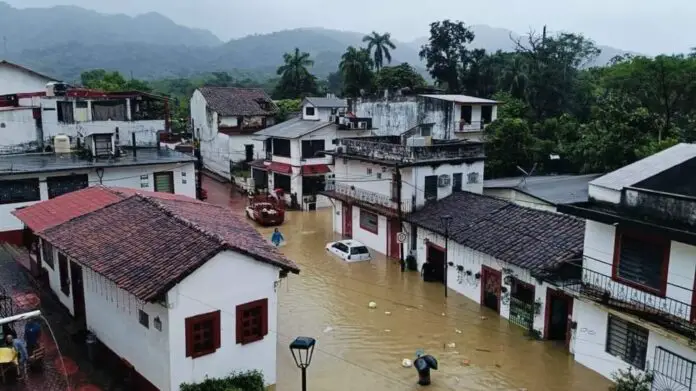Dozens of houses in Tabasco and other states reported damage due to the passage of ‘Nadine,’ which is expected to stop affecting the country this Sunday.
After impacting Mexico, Nadine degraded to a remnant low-pressure system while remaining on land, causing flooding in the southeast of the country this Sunday, October 20, which could worsen in the coming hours.
The National Water Commission (Conagua) reported that Nadine impacted Mexico this Sunday as a tropical depression.
Although it was expected to ‘survive’ its passage through Mexico to exit into the Pacific Ocean and intensify again, authorities said it weakened to almost disintegrating in the last few hours. As a result, it is only expected to affect the rainy season today.
In the last few hours, intense rains have been recorded, causing flooding, mainly in Tabasco.
The Passage of ‘Nadine’ in Southeastern Mexico
The alert for the combination of Cyclone Nadine and Cold Front 14 continues in Tabasco, where the rains have caused road closures and flooding in low-lying areas, such as the magical town of Villa Tapijulapa, in the municipality of Tacotalpa.
This Sunday, the town of 3,000 inhabitants, located in the mountainous area of the state, woke up with water inside the houses due to the overflow of the Amatán and Oxolotán rivers, forcing the affected residents to seek temporary shelter.
Additionally, a call has been made for cleanup efforts to be expedited as soon as the water level drops, to resume the tourism activities on which the families depend.
On Saturday, efforts were also made to remove a tree blocking the road out of the town. Meanwhile, the municipality reported that the passage of small vehicles on the road connecting the area with Jalapa and also towards Teapa is closed.
The mountainous region has been the most affected in the state due to the rapid rise of water levels and the strength of the current, so the Army, state, and municipal authorities are conducting patrols to support the population.
In Tacotalpa, 15 homes were reported flooded in the La Raya Zaragoza ejido due to the growth of a stream; a landslide on the road connecting the Buena Vista ejido; and as a preventive measure, due to the rise in the La Sierra river level, the gate in the municipality’s containment wall was closed.
Mayor Ricky Arcos Pérez reported that they were extracting accumulated water in the municipal seat with pumps.
“We had to lower the gate that protects the municipal seat because the river rose significantly, and we are pumping out the accumulated water, waiting for the river to drop so we can reopen this gate,” he said.
Meanwhile, the mayor of Jalapa, José Manuel Hernández Pérez, warned of the risk of being cut off due to the river, at the height of Astapa, taking part of the embankment and now being less than 20 meters from the road.
In this regard, he called on Conagua to take action and announced that 29 temporary shelters with a capacity to accommodate nearly 3,000 people have been activated.
In Teapa, the restriction on road traffic has been fluctuating; for hours, the passage of all types of vehicles has been closed, but this Sunday, heavy vehicles that can withstand the current’s impact are allowed to circulate, which has affected hundreds of hectares of bananas and led to the evacuation of some localities.
Although to a lesser extent, some impacts have also been reported in Cunduacán and Jalpa de Méndez due to the passage of the Samaria River.
The Civil Protection Institute of the State of Tabasco (IPCET) urged the population to stay informed through official communications regarding the weather forecasts, as moderate to heavy showers are expected for the state, along with wind gusts between 70 and 100 kilometers per hour in most of the region.
According to the organization, it is estimated that this Sunday, the river levels will continue to rise, especially those located in the mountainous area of the state and the Zanapa-Tonalá, Puxcatán, and Usumacinta basins.
Source: El Financiero






